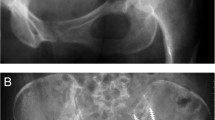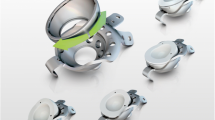Abstract
Introduction
The Burch–Schneider cage is an established implant in revision surgery after hip arthroplasty that is used for reconstructing osseous defects in the acetabulum. However, there are only a few reports about the use of cages in patients with metastatic destruction of the acetabulum. The aim of this retrospective study was to assess the outcome and complications of this procedure.
Methods
The records of 15 patients with metastatic acetabular defects using the Burch–Schneider cage were examined pre- and postoperatively. X-rays were analyzed, clinical and functional outcome was assessed by the Harris hip score (HHS) and the visual analogue scale (VAS) for subjective pain perception. The follow-up of 14 months was due to the underlying disease.
Results
The overall revision rate was 26%. The HHS improved from 33 (range 25–39) to 69 (range 35–93). The VAS improved from 7.5 to 3.2.
Conclusion
The life expectancy of patients with bone metastasis can be short and patients should be carefully selected for a surgical treatment. The implantation of a protrusio cage can improve the quality of life in these patients by increasing their mobility and reducing pain. The complication rate is comparable with the rates for other surgical methods for metastatic acetabular lesions. For surgeons who are familiar with this implant, it seems to be a good option in treating such cases.


Similar content being viewed by others
References
Schneider R (1980) Reinforcement of the cup in total hip prosthesis (author’s transl). Unfallheilkunde 83:482
Berry DJ, Muller ME (1992) Revision arthroplasty using an anti-protrusio cage for massive acetabular bone deficiency. J Bone Joint Surg Br 74:711
Wachtl SW, Jung M, Jakob RP, Gautier E (2000) The Burch–Schneider antiprotrusio cage in acetabular revision surgery: a mean follow-up of 12 years. J Arthroplast 15:959
Winter E, Piert M, Volkmann R, Maurer F, Eingartner C, Weise K et al (2001) Allogeneic cancellous bone graft and a Burch–Schneider ring for acetabular reconstruction in revision hip arthroplasty. J Bone Joint Surg Am 83-A:862
Tidermark J, Blomfeldt R, Ponzer S, Soderqvist A, Tornkvist H (2003) Primary total hip arthroplasty with a Burch–Schneider antiprotrusion cage and autologous bone grafting for acetabular fractures in elderly patients. J Orthop Trauma 17:193
Symeonides PP, Petsatodes GE, Pournaras JD, Kapetanos GA, Christodoulou AG, Marougiannis DJ (2009) The effectiveness of the Burch–Schneider antiprotrusio cage for acetabular bone deficiency: five to twenty-one years’ follow-up. J Arthroplast 24:168
Harrington KD (1981) The management of acetabular insufficiency secondary to metastatic malignant disease. J Bone Joint Surg Am 63:653
Harris WH (1969) Traumatic arthritis of the hip after dislocation and acetabular fractures: treatment by mold arthroplasty. An end-result study using a new method of result evaluation. J Bone Joint Surg Am 51:737
Gill TJ, Sledge JB, Muller ME (1998) The Burch–Schneider anti-protrusio cage in revision total hip arthroplasty: indications, principles and long-term results. J Bone Joint Surg Br 80:946
Hansen BH, Keller J, Laitinen M, Berg P, Skjeldal S, Trovik C et al (2004) The Scandinavian Sarcoma Group Skeletal Metastasis Register. Survival after surgery for bone metastases in the pelvis and extremities. Acta Orthop Scand Suppl 75:11
Pieringer H, Auersperg V, Bohler N (2006) Reconstruction of severe acetabular bone-deficiency: the Burch–Schneider antiprotrusio cage in primary and revision total hip arthroplasty. J Arthroplast 21:489
van Koeveringe AJ, Ochsner PE (2002) Revision cup arthroplasty using Burch–Schneider anti-protrusio cage. Int Orthop 26:291
Marco RA, Sheth DS, Boland PJ, Wunder JS, Siegel JA, Healey JH (2000) Functional and oncological outcome of acetabular reconstruction for the treatment of metastatic disease. J Bone Joint Surg Am 82:642
Perka C, Ludwig R (2001) Reconstruction of segmental defects during revision procedures of the acetabulum with the Burch–Schneider anti-protrusio cage. J Arthroplast 16:568
Stark A, Bauer HC (1996) Reconstruction in metastatic destruction of the acetabulum. Support rings and arthroplasty in 12 patients. Acta Orthop Scand 67:435–438
Vena VE, Hsu J, Rosier RN, O’Keefe RJ (1999) Pelvic reconstruction for severe periacetabular metastatic disease. Clin Orthop Relat Res (362):171
Clayer M (2010) The survivorship of protrusio cages for metastatic disease involving the acetabulum. Clin Orthop Relat Res 468:2980
Nilsson J, Gustafson P, Fornander P, Ornstein E (2000) The Harrington reconstruction for advanced periacetabular metastatic destruction: good outcome in 32 patients. Acta Orthop Scand 71:591
Parikh SN, Kreder HJ (2005) Pelvic reconstruction for massive acetabular insufficiency. Clin Orthop Relat Res (434):217
Allan DG, Bell RS, Davis A, Langer F (1995) Complex acetabular reconstruction for metastatic tumor. J Arthroplast 10:301
Tillman RM, Myers GJ, Abudu AT, Carter SR, Grimer RJ (2008) The three-pin modified “Harrington” procedure for advanced metastatic destruction of the acetabulum. J Bone Joint Surg Br 90:84
Author information
Authors and Affiliations
Corresponding author
Rights and permissions
About this article
Cite this article
Hoell, S., Dedy, N., Gosheger, G. et al. The Burch–Schneider cage for reconstruction after metastatic destruction of the acetabulum: outcome and complications. Arch Orthop Trauma Surg 132, 405–410 (2012). https://doi.org/10.1007/s00402-011-1351-0
Received:
Published:
Issue Date:
DOI: https://doi.org/10.1007/s00402-011-1351-0




